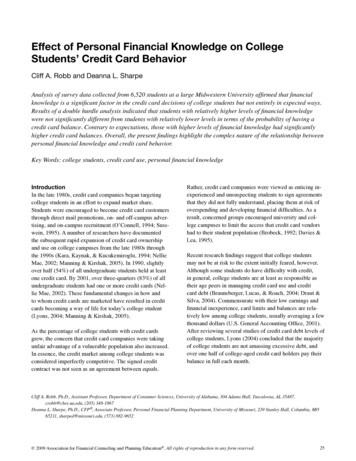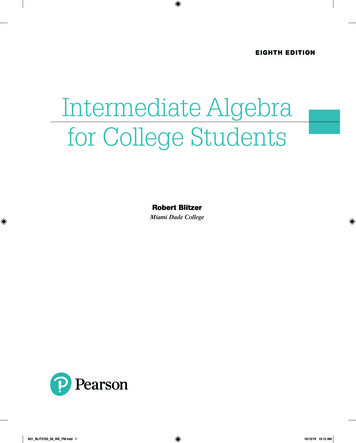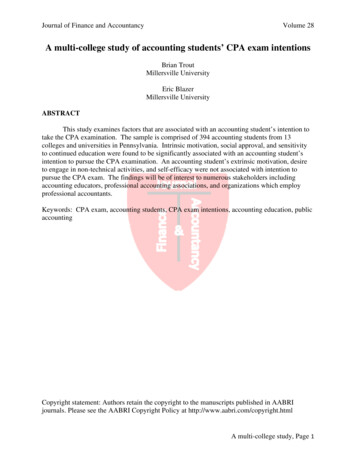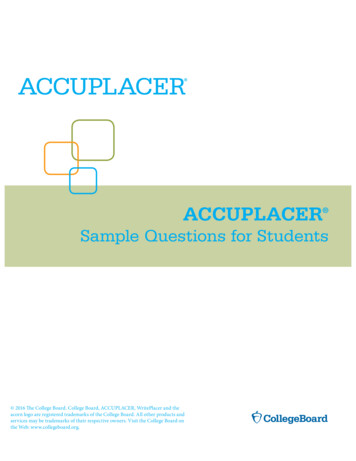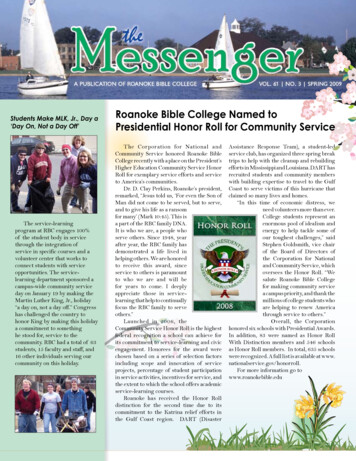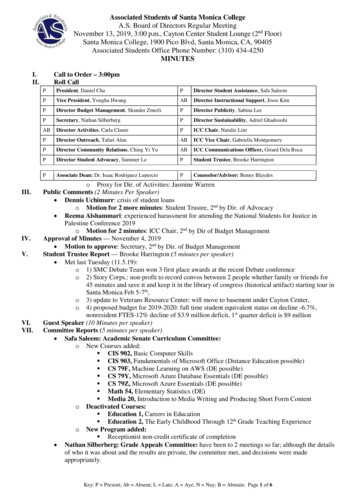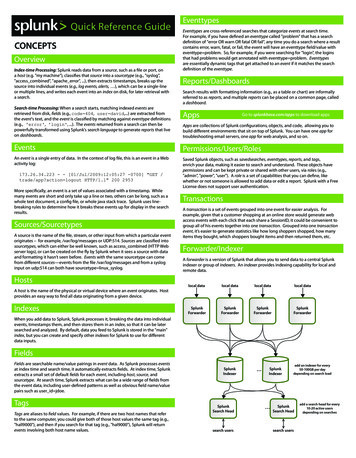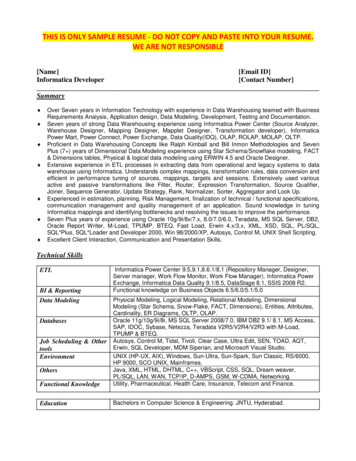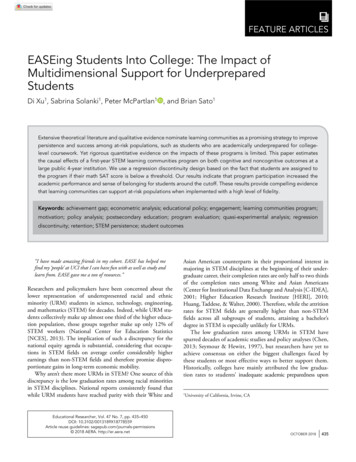
Transcription
778559Educational ResearcherEducational ResearcherFeature ArticlesEASEing Students Into College: The Impact ofMultidimensional Support for UnderpreparedStudentsDi Xu1, Sabrina Solanki1, Peter McPartlan1 , and Brian Sato1Extensive theoretical literature and qualitative evidence nominate learning communities as a promising strategy to improvepersistence and success among at-risk populations, such as students who are academically underprepared for collegelevel coursework. Yet rigorous quantitative evidence on the impacts of these programs is limited. This paper estimatesthe causal effects of a first-year STEM learning communities program on both cognitive and noncognitive outcomes at alarge public 4-year institution. We use a regression discontinuity design based on the fact that students are assigned tothe program if their math SAT score is below a threshold. Our results indicate that program participation increased theacademic performance and sense of belonging for students around the cutoff. These results provide compelling evidencethat learning communities can support at-risk populations when implemented with a high level of fidelity.Keywords: achievement gap; econometric analysis; educational policy; engagement; learning communities program;motivation; policy analysis; postsecondary education; program evaluation; quasi-experimental analysis; regressiondiscontinuity; retention; STEM persistence; student outcomes“I have made amazing friends in my cohort. EASE has helped mefind my ‘people’ at UCI that I can have fun with as well as study andlearn from. EASE gave me a ton of resources.”Researchers and policymakers have been concerned about thelower representation of underrepresented racial and ethnicminority (URM) students in science, technology, engineering,and mathematics (STEM) for decades. Indeed, while URM students collectively make up almost one third of the higher education population, those groups together make up only 12% ofSTEM workers (National Center for Education Statistics[NCES], 2013). The implication of such a discrepancy for thenational equity agenda is substantial, considering that occupations in STEM fields on average confer considerably higherearnings than non-STEM fields and therefore promise disproportionate gains in long-term economic mobility.Why aren’t there more URMs in STEM? One source of thisdiscrepancy is the low graduation rates among racial minoritiesin STEM disciplines. National reports consistently found thatwhile URM students have reached parity with their White andEducational Researcher, Vol. 47 No. 7, pp. 435 –450DOI: 10.3102/0013189X18778559Article reuse guidelines: sagepub.com/journals-permissions 2018 AERA. http://er.aera.netAsian American counterparts in their proportional interest inmajoring in STEM disciplines at the beginning of their undergraduate career, their completion rates are only half to two thirdsof the completion rates among White and Asian Americans(Center for Institutional Data Exchange and Analysis [C-IDEA],2001; Higher Education Research Institute [HERI], 2010;Huang, Taddese, & Walter, 2000). Therefore, while the attritionrates for STEM fields are generally higher than non-STEMfields across all subgroups of students, attaining a bachelor’sdegree in STEM is especially unlikely for URMs.The low graduation rates among URMs in STEM havespurred decades of academic studies and policy analyses (Chen,2013; Seymour & Hewitt, 1997), but researchers have yet toachieve consensus on either the biggest challenges faced bythese students or most effective ways to better support them.Historically, colleges have mainly attributed the low graduation rates to students’ inadequate academic preparedness upon1University of California, Irvine, CAOctober 2018 435
college enrollment. This argument has been increasingly challengedin the literature on college persistence and success; indeed, in thepast two decades, a greater number of researchers have highlightedthe importance of engaging students both academically and socially(e.g., Bergen & Milem, 1999; Kuh, Kinzie, Schuh, & Whitt, 2005;Robinson, 1996; Tinto, 2017).A number of institutionalized efforts have been made toprovide students with academic and social support, such aspeer advising, intrusive academic advising, student coaching,and cohorting programs (Bettinger & Baker, 2014; DiMaria,2006; Smith, MacGregor, Matthews, & Gabelnick, 2004;MDRC, 2012). One promising institutionalized effort to support students in both domains simultaneously is through learning communities (Smith et al., 2004). Broadly defined as agroup of students sharing learning activities together, learningcommunities intend to support students academically as wellas connecting students emotionally. However, while an extensive theoretical literature and qualitative evidence nominateslearning communities as a promising strategy to improve persistence and success among at-risk populations in college, suchas students who are academically underprepared for collegelevel coursework (see Dagley, Georgiopoulos, Reece, & Young,2015; Engstrom & Tinto, 2007; Scrivener et al., 2008; Shapiro& Levine, 1999; Smith et al., 2004; Taylor, Moore, MacGregor,& Lindblad, 2003; Tinto & Goodsell, 1993; Tinto & Russo,1994; Zhao & Kuh, 2004), experimental and quasi-experimental evidence on the impacts of existing programs on students’ academic performance and social integration is stilllimited. This is particularly the case in regard to learning communities in specific fields of study, such as STEM-focusedlearning communities.This paper estimates the causal effects of a first-year learningcommunities program—Enhanced Academic Success Experienceinitiative (EASE)—provided to freshmen majoring in biologicalsciences (bio sci) at a large public Hispanic-serving institution(HSI), using a regression discontinuity (RD) design based on thefact that students are assigned to the program if their math SATscore falls below a threshold. EASE represents a strong institutionalized effort, and two key features distinguish it from mostof the existing learning communities. First, instead of allowingstudents to volunteer into the program, EASE students weregrouped into cohorts of 30. Each student cohort was enrolled inthe same lecture and discussion sections of all major-relatedcourses throughout the freshman year. The main goal was forthese small groups to engage in shared learning activities anddevelop stronger student relationships, thereby increasing students’ sense of belonging to the major and at the college. Second,additional academic and social support was provided to studentsenrolled in EASE, where each cohort of 30 was connected witha senior bio sci major who mentored them by providing adviceand conducting 1-hour weekly meetings with the cohort. Thepersonalized advising and guidance intends to not only bridgestudents’ informational gaps but also support the students indeveloping academic and social-emotional skills throughouttheir first year in college.We examine the impact of the program on a variety of outcome measures, including course performance in gateway biology courses, cumulative first-year GPA, and retention within the436 EDUCATIONAL RESEARCHERbio sci major, as well as noncognitive measures of social integration, such as a sense of belonging as a bio sci major. Our resultsindicate that EASE participation significantly increased students’grades in core college-level courses and first-year cumulativeGPA, boosted students’ sense of belonging to the bio sci major,and most importantly, improved first-year major persistence forstudents on the margin of being eligible to participate in theprogram. We conduct several robustness checks to rule out alternative explanations for these findings. These promising resultsprovide compelling evidence that learning communities programs can provide effective support to at-risk populations whenimplemented with a high level of fidelity.Theoretical Framework and Extant ResearchLearning communities represent an educational strategyintended to improve college student engagement and success. Itis informed by Tinto’s (1975) integration theory, which positsthat academic and social integration are key components of academic performance and both college student retention and persistence (Astin, 1984; Braxton & McClendon, 2001; Carini,Kuh, & Klein, 2006; Tinto, 1975; Tinto & Goodsell, 1993).Tinto’s theory offers colleges and universities a model of student persistence in which academic integration (AI), referring toa student’s academic performance and course-related conduct, ismarked by behaviors such as attending class, completing courses,interacting with faculty, and attending study groups. Social integration, the other main component of Tinto’s theory, consists oftwo components: a student’s level of participation in the socialculture of a college, such as through campus-related activities,and perceived social integration.Modern theorists have placed greater emphasis on the secondcomponent, positing that a subjective sense of belonging (defined asfeeling acceptance, respect, and inclusion as well as feeling valued within a group) is a critical component of social integrationand is particularly relevant to student learning outcomes(Hurtado & Carter, 1997; Strayhorn, 2012). Indeed, researchhas shown that the psychological processes associated withsense of belonging have the potential to interfere with academic function, as common challenges become much moresevere when students feel they are the only ones dealing withthem or when they feel that those of their demographic do notoften succeed (Strayhorn, 2008, 2012). Low-income, first-generation, and URM college students—as well as women inmale-dominated majors—often fit these criteria (Darling,Molina, Sanders, Lee, & Zhao, 2008; Freeman, Anderman, &Jensen, 2007; Hoffman, Richmond, Morrow, & Salomone,2003; Hurtado & Carter, 1997; Master, Cheryan, & Metzloff,2016; Ostrove & Long, 2007; Strayhorn, 2008, 2012). Further,research has shown that sense of belonging is particularly relevant in STEM courses, as it is common for STEM students tofind that their racial or gender groups are underrepresented(Murphy & Zirkel, 2015). In short, all existing studies point tothe idea that developing a strong sense of belonging early inone’s college career is key.Learning communities emerge in the midst of this discussionas a way for colleges and universities to promote academic andsocial integration simultaneously. They are intentionally
designed to increase opportunities for students to interact withpeers, faculty, and the curriculum, therefore allowing for theconstruction of a strong support system and the development ofa strong sense of belonging (Smith et al., 2004).The majority of learning communities incorporate active andcollaborative learning activities (e.g., students co-enrolling incourses) and promote involvement in complementary academicand social activities that extend beyond the classroom (e.g., students meet weekly in a study skills course and/or with a groupmentor) (Zhao & Kuh, 2004). Indeed, prior research has documented that first-year students who participate in a learningcommunity have higher grades, retention rates, and self-reportedlevels of engagement when compared to peers who have not hada learning community experience. Further, learning communitystudents have reported studying more with peers outside of classand becoming more involved in university activities (Engstrom& Tinto, 2007; Shapiro & Levine, 1999; Taylor et al., 2003;Tinto & Goodsell, 1993; Tinto & Russo, 1994; Zhao & Kuh,2004).Despite these promising factors, most of the existing researchthat examines the correlation between participation in learningcommunities and student college experiences is based on voluntary enrollment in the communities. While this research hasgenerally identified a positive correlation between participationin learning communities and improved academic and social outcomes, it is possible that these results are subject to biases regarding students’ self-selection into these programs.The most rigorous evaluation of learning communities todate is the Learning Communities Demonstration by MDRC(2012), an evaluation of a one-semester learning communitiesprogram for students assigned to developmental English classesat six community colleges. Within each college, students from avariety of fields were randomly assigned to participate in thelearning communities program during their initial semester incollege. In general, the study found a small positive impact onacademic-related measures, such as credits earned, but failed tofind any consistent evidence demonstrating that learning communities positively influenced students’ persistence. Importantly,however, the study also found that students in the KingsboroughOpening Doors Learning Communities program, which provided enhanced support services such as academic counselingand tutoring to students—a feature distinguishing it from theother five programs—reported a noticeably larger impact onacademic credits earned than that reported by the other campuses. This suggests that more comprehensive learning community programs providing intensive support services may yieldgreater benefits; in fact, a separate report from MDRC (Scriveneret al., 2008) discussing the 6-year follow-up results of theKingsborough program identified the positive impact of program participation on graduation rates.Overall, researchers have theorized that learning communities—particularly those with enhanced support services—are a promising way to improve the college experience and student learningoutcomes. To date, the rigorous evaluations that do exist demonstrate what a typical learning communities program looks likeand delineate the average impact in the community college context. In this study, we contribute to the discussion about learningcommunities by documenting and rigor
bio sci major, as well as noncognitive measures of social integra-tion, such as a sense of belonging as a bio sci major. Our results indicate that EASE participation significantly increased students’ grades in core college-level courses and first-year cumulative GPA, boosted students’ sense of belonging to the bio sci

